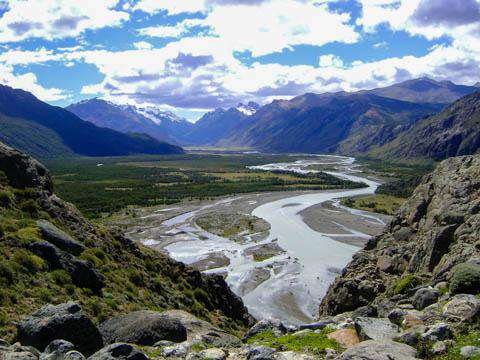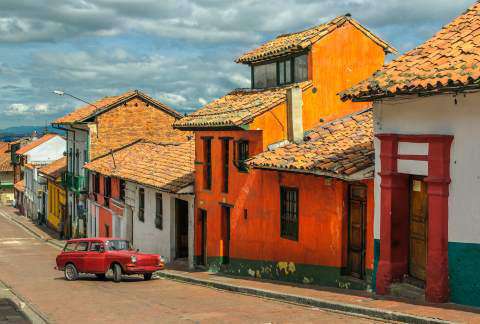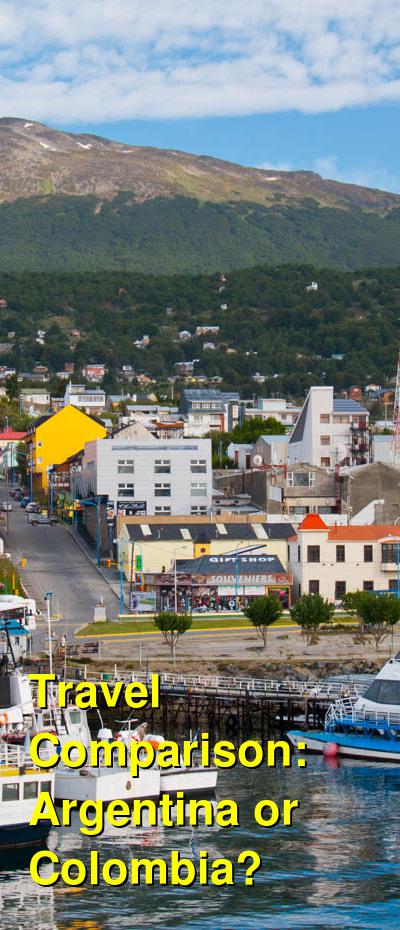Should you visit Argentina or Colombia?
When comparing the travel costs for Argentina and Colombia, for most travelers Argentina is more expensive. Both countries can be quite affordable and offer plenty of activities and experiences for visitors.
The top three destinations in Argentina are even more diverse as they include the romantic capital of Buenos Aires, the majestic Iguazu Falls on the border with Brazil and Los Glaciares National Park in Patagonia for the colossal Perito Moreno. In terms of spectacular scenery, Argentina perhaps has the edge here, being home to the Iguazu Falls, one of the world's most spectacular waterfalls and the Perito Moreno, one of the nation's top tourist attractions and a truly humbling sight. Argentina is perhaps a better destination for wildlife lovers, being home to one of the most celebrated spots. The Peninsula Valdes on coastal Patagonia provides habitats for a great variety of amazing creatures; a truly magical sight. Whales, elephant seals, sea lions and let's not forget the Punta Tombo Reserve, where the world's biggest colony of penguins resides.
Long synonymous with drug cartels, kidnappings and corruption, the last two decades have seen Colombia evolve from failed narco state into one of Latin America's greatest destination. New restaurants, boutique hotels and craft breweries are appearing across Bogota, as local entrepreneurs capitalize on the country's newfound peace. In 2013, Medellin was voted the world's most innovative city: art, tourism and an impressive new cable car network have all contributed to the rebirth of this incredible city. You will see sculptures scattered around Medellin from Fernando Botero, the figurative painter and sculptor famed for his satirical works, which feature oversized subjects in exaggerated form. In addition, Bogota's decision to decriminalize graffiti in 2011 marked a creative new era for the city, whose flyovers, office blocks and municipal walls became canvases for some of the world's most exceptional street art. Cartagena is one of the most fabulous colonial cities in Latin America. You can dance in all-night salsa clubs in the southern city of Cali, which has the honorable distinction of being Colombia's salsa capital.
Colombia has plenty of hidden treasures. Trekking to the ruins of the mysterious Ciudad Perdida is one of Colombia's most rewarding adventures. Constructed some 650 years before Peru's Machu Picchu, Ciudad Perdida was only re-discovered in 1976. This ancient city is hidden in dense jungle atop the Sierra Nevada de Santa Marta, a six-day hike from the nearest town. Mompox is also not very easy to access and has largely been bypassed by tourists, but it is well worth making an effort for. Not only is this sleepy city a place of beauty, with its well-preserved architecture and riverside location, but it was also the inspiration behind Gabriel Garcia Márquez's magical realism novel, One Hundred Years of Solitude.
Colombia also has some wonderful popular attractions such as an underground salt cathedral in the quiet, colonial city of Zipaquira, a short drive or train trip from Bogota, a heritage railway, which offers a unique perspective on Bogota and the surrounding countryside, and the Guatape Lake, which is actually the result of a controversial dam. Colombia is also home to one of South America's prettiest national parks.
Tayrona National Park has all the attributes you want from the Caribbean, swaying palms, sandy beaches, limpid lagoons but being a protected area in Colombia's northern wilderness, this coastal reserve is refreshingly free of development. Colombia also has one of the world's biggest carnivals. The Barranquilla Carnival takes place 40 days before Holy Week, and the streets are filled with parades and parties, a big attraction for tourists, who are warmly received by locals.
Which country is cheaper, Colombia or Argentina?
Should I visit Argentina or Colombia? This is a popular question for many travelers. By figuring out which country is more expensive, you'll understand where you'll get more bang for your buck. A week in Colombia can cost you about $324 (per person), while a week in Argentina may cost you around $74. These differences become even more noticable if you plan to spend a longer time in the country. 10 days, two weeks, or even one month of travel to Colombia or Argentina can really add to your travel budget.
Accommodation is often cheaper in Argentina compared to Colombia ($3.33 vs. $15). Budget travelers often stay in cheaper hostels and guest houses, while nicer hotels usually appeal to families and upscale travelers.
Compare hotel prices here: Argentina Hotel Prices and Colombia Hotel Prices.
Or, compare hostel and guesthouse prices between Colombia and Argentina to find the cheapest accommodation here: Colombia hostels and Argentina hostels.
When comparing food in Argentina vs. Colombia they are not just different in cuisine, but also in price. Meal and restaurant costs in Argentina ($3.41) are often cheaper than Colombia ($12).
When is the best time to visit Argentina and Colombia?
 El Chalten, Argentina
El Chalten, Argentina
If you are planning to hike through Patagonia and visit the natural wonders, then prioritize mid-seasons. Either go around September to November or from March to May. Both are low seasons, but the spring landscape, September to November, is the nicest of the two. If you do not handle the cold very well, avoid going to Patagonia before mid-October and after April. On the other hand if you love the snow, winter landscapes, skiing and travelling during low season with few tourists and lower prices, you should definitely visit Patagonia during end of autumn or beginning of spring. While you will get all the advantages of travelling during low season, you will also be able to enjoy a sunny weather, still quite cold but manageable. While a few activities (hikes, excursions) will begin to close (end of autumn) or still be closed (towards spring), you will definitely be able to do most of the essential activities and to fully enjoy some of them as you might find that you have a hiking path all to yourself! The differences in prices between low and high season are not tremendous but you will probably be able to save some money on deals with accommodation and a few other fees.
Colombia is a year-round destination, particularly along the Caribbean coast and in Medellin where warm, dry weather is prevalent for almost the entire year. Weather variations are determined more by region than clearly defined seasons. The dry season, which makes the high-season for tourists in Colombia is from December to March. With plenty of sunny days; ideal for exploring the country's charming towns and cities, the coffee district, cultural highlights, beautiful countryside, jungles and relaxing on the beach, Colombia is filled with domestic holidaymakers and international visitors. Early planning is crucial for December and January. Also remember that in the highlands, nights become chilly in areas of higher altitude all year-round. The lowlands enjoy a tropical climate during the whole year with little temperature variation, though more frequent rain showers will be noticeable in the wetter months of April to June and again in October and November. The start of the rainy season brings slightly wetter weather in some places, but persistent rainfall is very unusual. Long spells of dry weather can still be enjoyed, and many take advantage of off-peak travel to get a wider choice of hotels and lower rates than in the months to follow.
Why is Argentina more expensive than Colombia?
The last decade in Argentina has seen prices and currency exchange rates fluctuate greatly. Because of this, travel prices have generally risen as the overall economy is growing but economic uncertainty remains. It is best to plan ahead, do research into all options for accommodation, tours, and meals, and have a good understanding of the prices that lay ahead for your trip. But keep in mind that when travelling in Argentina, it's easy to be laid back about buying transportation tickets on the day of travel and it often makes no difference at all to do so, as prices are held steady usually by the overall price of fuel.
Compared to other South American countries, Colombia is not the cheapest destination but certainly not the most expensive either. The falling value of the peso also makes it cheaper for foreign tourists than it was just a few years ago. The cost of living remains fairly low and there is not much difference in budget when travelling in Colombia or Ecuador.Activities are quite affordable by Western standards. For example, a paragliding session in San Gil costs USD$21 for a short flight and USD$60 or Â49 for a longer one. An hour-long private salsa dancing lesson in Medellin costs around USD$17. Museum entry is often free or only a couple of thousand pesos. Your biggest expense might be the 5 or 6 day Ciudad Perdida trek near Santa Marta, if this will be part of your itinerary. The price is standardized at $250 regardless of which trekking company you choose. While it is a bigger one-off expense, you also won't have to pay for food or accommodation for almost a week. Colombia is twice the size of France and bus travel is moderately expensive, so if you will be moving around the country a lot then this will add to your expenses.
What are the most expensive and cheapest cities and regions in Argentina and Colombia?
 La Candalaria, Bogota, Colombia
La Candalaria, Bogota, Colombia
Buenos Aires, in Argentina, is one of the world's most recognizable tourist destinations. It's the birthplace of the tango, has stunningly preserved colonial architecture, a buzzing nightlife scene, and one of the world's trendiest neighborhoods. Buenos Aires but also other northern large cities such as Cordoba, Rosario and Mendoza are known to be rather expensive cities in Latin America. If you decide to visit the wine region, you can buy your own groceries and do your own bike tours in Mendoza to save a considerable amount of money but consider Mendoza as one of your splurge cities.
Southern Patagonia tends to be cheaper than the North. However, travelling through this large piece of land requires a certain budget and certain cities are surprisingly expensive. In the small towns of Patagonia, costs tend to be cheap due to competition. However, sometimes transportation can get pricey and the more frequently visited a destination by tourists, the higher the prices can get. The time of year and festivals can also dramatically affect cost.
The most touristy and also priciest location in Colombia is the beautiful and historic colonial city of Cartagena. Cartagena's Old Town is a Unesco World Heritage site, a maze of cobbled alleys, balconies covered in bougainvillea, and massive churches that cast their shadows across leafy plazas. Beyond this, there are some expected price differences between the cities like Bogota or Medellin and the countryside.
How you can save money when visiting Argentina and Colombia?
Don't fly domestically, as a two-hour flight can cost a lot. Unless you are in a rush, consider taking long distance buses.
The first tip to save money in Colombia is to negotiate. Prices for bus tickets and taxis are sometimes negotiable, so try to haggle to bring the costs down. In the off-season, you can also negotiate the price of your guesthouses if you speak Spanish.
If you're a student, make sure to bring your student card to get discounts at many of the museums and tourist sites in the country. Also many museums around the country are free on Sundays. However be sure to arrive early to beat the crowds, as they will be much busier.
Many hostels and hotels will include free breakfast so be sure to stay at a place that does so you can save on your food budget.
Take a free walking tour. Free Walking Tour Bogota offers an informative and insightful tour around the city, serving as a great introduction to the local way of life as well as the city's history. Real City Tours offer a free tour in Medellin, as well.
Uber is way cheaper than taxis and are the best way to get around a city if you don't want to wait for a bus or pay for a taxi. The Uber Pool option is where can you share a ride to get even better savings.).


 Budget Your Trip is all about finding out how much everything costs so that you can travel cheaper and longer. Created by avid travelers Laurie and Bryan, our goal is to help you plan your next trip on the right budget. With average daily travel costs that are calculated from the budgets of real travelers, plus an analysis of hotel and tour prices, you can find out how much money you need to plan your next adventure. We also have plenty of travel advice, accommodation reviews, and activity suggestions.
Budget Your Trip is all about finding out how much everything costs so that you can travel cheaper and longer. Created by avid travelers Laurie and Bryan, our goal is to help you plan your next trip on the right budget. With average daily travel costs that are calculated from the budgets of real travelers, plus an analysis of hotel and tour prices, you can find out how much money you need to plan your next adventure. We also have plenty of travel advice, accommodation reviews, and activity suggestions.
